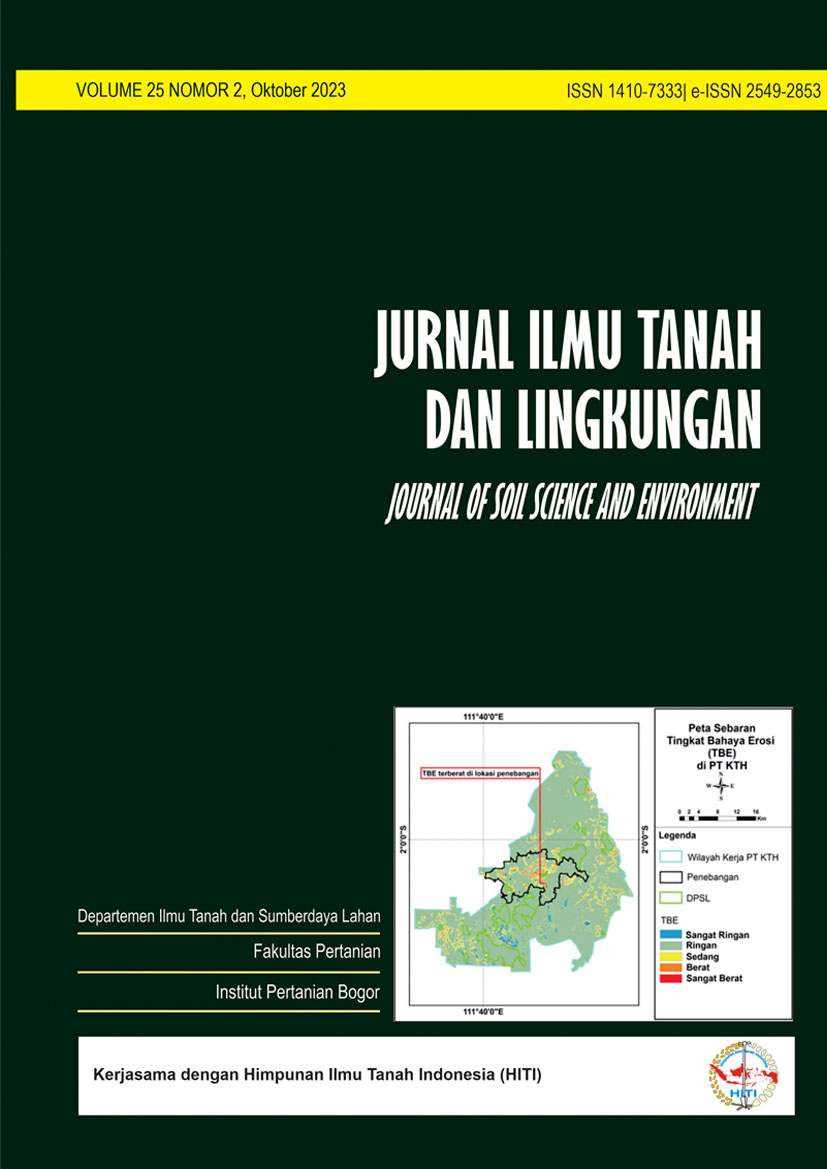Erosion Hazard Vulnerability and Soil Fertility Status in Forest Plantation Concession in Central Kalimantan
Abstract
Land cover changes alter surface run off rate and erosion rate as well. The land clearing, as a part of the implementation of silvicultural system of forest plantation (THPB) remove all of vegetative covers which temporarily reduce evapotranpiration and hence increase surface erosion. Surface erosion may erode soil particles, leach nutrients and decrease soil fertility. This research estimated and mapped the rate of erosion, erosion hazard vulnerability, and soil fertility status in forest plantation concession in Central Kalimantan. The results showed that soil rate under Acacia, Eucalyptus, DPSL (undisturbed area), Harvesting Area and Skidding Road are: 3.0, 3.2, 1.5, 4.8, dan 5.0 (ton ha-1 year-1), respectively. Although erosion rate was relatively high, such as in the Harvesting and Skidding Road, the erosion hazard vulnerability (TBE) was still low due to deep soil stratum. Based on the analysis of soil samples, almost all areas had low pH and fertility.
Downloads
References
Asdak C. 2002. Hidrologi dan Pengelolaan Daerah Aliran Sungai. Yogyakarta (ID): Gadjah Mada University Press. 618hlm
[Balitbang Tanah] Badan Penelitian Tanah. 2006. Sifat Fisika Tanah dan Metode Analisisnya. Bogor (ID): Balai Besar Penelitian Sunberdaya lahan Pertanian, Balitbang Pertanian Departemen Pertanian. 286hlm
Bruijzneel LAS. 1997. Hydrology of Forest Plantation in The Tropics. Di dalam: Nambiar EKS, Brown AG, editor. Managemen of Soil, Nutrients and Water in Tropical Plantation Forest. Canberra (AU): ACIAR Monograph (43): 125-168p
Chang M. 2006. Forest Hydrology: An Introduction to Water and Forests. Texas (US): Taylor and Francis Group. 474p
[Dephut] Departemen Kehutanan. 1998. Pedoman Penyusunan Rencana Teknik Rehabilitasi Teknik Lapangan dan Konservasi Tanah Daerah Aliran Sungai. Jakarta (ID): Departemen Kehutanan.
DHV Consulting Engineeer. 1989. Study on Catchment preservation and on Enviromental Impact of the Water Suplay Project of Bandung dan Sukabumi. Ministry of Public Works. Directorate General Cipta Karya.
Douglas I, Spencerr T, Greer T, Bidin K, Sinun W, Wong WM. 1992. The Impact of Selective Commercial Logging on Stream Hydrology, Chemistry and Sediment load in The Ulu SAGAMA Rainforest, Sabah. London (UK): Phil. TransR. Soc. Land. B335: 397-406p
Driessen, P. M. 1978. Peat soils. In IRRI Ed., “Soils and Rice”, pp. 763-769. IRRI, Los Baños, Philippines.
Fahrunsyah. 2012. Studi Karakteristik Kimia Tanah dan Status Kesuburan Tanah di Kawasan Sentra Produksi Tanaman Pangan Kabupaten Tana Tidung. Samarinda (ID): Jurusan Agroteknologi, Fakultas Pertanian, Universitas Mulawarman. Zirra’ah. 33(1):1-9
Fölster H and Kanna PK. 1997. Dynamics of Nutrient Supply in Plantation Soils. Di dalam: Nambiar EKS, Brown AG, editor. Managemen of Soil, Nutrients and Water in Tropical Plantation Forest. Canberra (AU): ACIAR Monograph (43): 339-378p
Fujii, Kazumichi, Arief Hartono, Shinya Funakawa, Mari Uemura, Sukartiningsih, and Takashi Kosaki. 2011. “Acidification of Tropical Forest Soils Derived from Serpentine and Sedimentary Rocks in East Kalimantan, Indonesia.” Geoderma 160 (3–4): 311–23. https://doi.org/10.1016/j.geoderma.2010.09.027.
Funakawa, S., K. Yonebayashi, F. S. Jong, and C. O. Khun Ernest. 1996. “Nutritional Environment of Tropical Peat Soils in Sarawak, Malaysia Based on Soil Solution Composition.” Soil Science and Plant Nutrition 42 (4): 833–843. doi:10.1080/00380768.1996.10416630.
Hardjowigeno S. 2007. Ilmu Tanah. Jakarta (ID): Akademika Pressindo. 233hlm
Hartemink A. 2003. Soil Fertility Decline in the Tropics with Case Studies on Plantations. Wageningen (NL): International SoilReference and Information Centre (ISRIC). 375p
Indranada HK. 1989. Pengelolahan Kesuburan Tanah. Jakarta (ID): Bina Aksara. 90hlm
Khasanah N, Lusiana B, Farida, Noordwijk M van. 2004. Simulasi Limpasan Permukaan dan Kehilangan Tanah pada Berbagai Umur Kebun Kopi: Studi Kasus di Sumberjaya, Lampung Barat. Bogor (ID): ICRAFT SE Asia. Agrivita. 26(1)
[Kemenhut] Kementerian Kehutanan. 2012. Statistik Kehutanan Indonesia. Kementerian Kehutanan 2011. Jakarta (ID): Kementerian Kehutanan.
Mackensen J. 2000. Pengelolaan Unsur Hara pada Hutan Tanaman Industri (HTI) di Indonesia: Petunjuk praktis kearah pengelolaan unsur hara terpadu. Sundawati L. penerjemah. Eschborn (DE): o.K.-Kopie. 133p
Matangaran JR. 2002. Pemulihan Kepadatan Tanah pada Jalan. Bogor (ID): Laboratorium Keteknikan Pemanenan, Jurusan Teknologi Hasil Hutan, Fakultas Kehutanan IPB. J Teknologi Hasil Hutan. 15 (2)
Mitasova H. et al. 1999. Using Soil Erosion Modeling for Improved Conservation Planning: A GIS-based Tutorial [Internet]. Urbana (US): Geographic Modelling System Laboratorium University of Illinois at Urbana-Champaign. [Diunduh 21 Januari 2013]
Saptarini NCL., Kironoto BA., Jayadi R., 2007. Kajian Perubahan Erosi Permukaan Akibat Pembangunan Hutan Tanaman Industri di Areal Pencadangan HTI Kabupaten Ketapang Propinsi Kalimantan Barat [Skripsi]. Yogyakarta (ID): Universitas Gadjah Mada
Storey. P. J. 2003. The Conservation and Improvement of Sloping Land. Volume II: Practical Aplication and Soil Improvement. Schience Publishers. Enfield-USA. 251p
Wischmeier WH. and Smith DD. 1978. PredictingRainfall Erosion Losses: A Guide to Conservation Planning. Washington DC (US): Agriculture Handbook No. 537. USDA/Science and Education Administration, Govt. Printing Office. 58p
Copyright (c) 2023 Jurnal Ilmu Tanah dan Lingkungan

This work is licensed under a Creative Commons Attribution-ShareAlike 4.0 International License.
Department of Soil Science and Land Resources Departemen Ilmu Tanah dan Sumberdaya Lahan, Faculty of Agriculture Fakultas Pertanian, IPB University




















